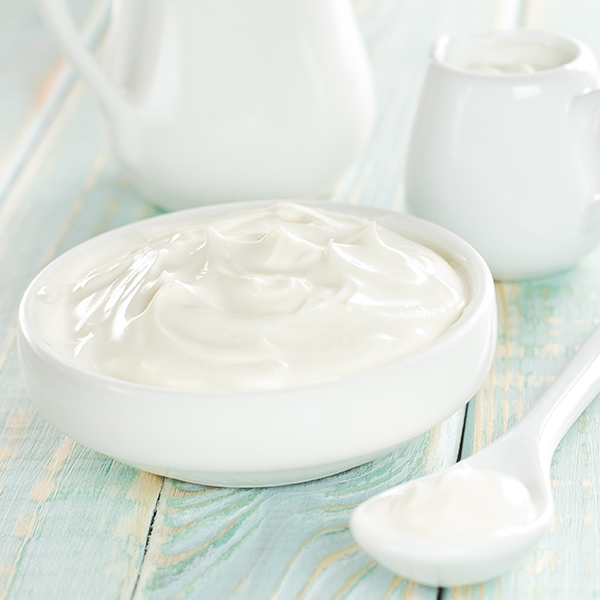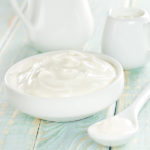Healthy, easy, inexpensive – what more could you ask for?
**This post contains affiliate links for products I personally use and recommend. This helps keep this website running at no additional cost to you!**
Yogurt has well-known health benefits including the presence of good bacteria that help keep our gut healthy. More and more research is being done on the importance of good gut health and how this impacts our overall health. Many people don’t even realize it is possible to make yogurt at home! Easy Homemade Instant Pot yogurt is healthy and saves you money!
Important Note: You have to make sure your Instant Pot (or other multicooker) has a yogurt setting. All the newer models do. This recipe will not work without that.

What’s In It?
Have you ever read the label on your yogurt? Yes, you can certainly find high-quality brands that only have milk, sugar (or fruit flavoring), and the bacteria culture; and if you are not interested in making your own – that is a good alternative. But, since you are here reading this you are interested in making it yourself! You will also be saving quite a bit of money.
Homemade instant pot yogurt takes a little bit of time but it is really easy and you know exactly what is going into it. Milk and a starter culture. Two ingredients. Easy! Bonus, it is so delicious!
Ingredients in store-bought yogurt:
There are store bought brands that have simple ingredients: Pasteurized Whole Milk, Pasteurized Cream and Active Cultures (Siggi’s). This is good! This is the same list of ingredients you would use to make homemade yogurt.
Other brands have much longer lists of ingredients including cane sugar, cornstarch, carob bean gum, carrageenan, chickory root fiber, and pectin. Some even list water as the second ingredient. Why are they adding water? Not sure.
That is not to say that these ingredients are necessarily bad but some are questionable.
Carob bean gum
Carob bean gum (also known as locust bean gum) has been used for many years and has been studied and found little to no toxicity or carcinogenic properties. (I’m not sure I love the “little to no” statement) It is used as a thickener and can be found in some infant formula. https://www.sciencedirect.com/science/article/pii/S0273230014001470
Cornstarch
Cornstarch is safe but nutritionally dense. Basically pure carbohydrates. Not necessary in yogurt! It just adds empty calories with no nutritional benefit.
Carrageenan
This ingredient is somewhat controversial in that some sources say it’s safe and others say it has cancer-promoting effects. For this reason, I personally would choose to avoid it. From what I could find there haven’t been any recent studies done (as of March 2020).
“Because of the acknowledged carcinogenic properties of degraded carrageenan in animal models and the cancer-promoting effects of undegraded carrageenan in experimental models, the widespread use of carrageenan in the Western diet should be reconsidered.”
https://www.ncbi.nlm.nih.gov/pmc/articles/PMC1242073/
What equipment will I need?
- Instant Pot (any model with the yogurt feature – see below for model comparison)
- Digital Thermometer
- Whisk
- Bowl and ladle (or large spoon) for tempering
- Yogurt Strainer
- Container to store starter
- Containers to store yogurt
Many sources suggest that the materials used to make and store the yogurt should be sterilized. Either using your Instant Pot or by boiling in water.
Which Instant Pot or other cooker can I use?
There are SO many choices on the market currently and new models being released all the time. I like to research my options and make sure it is something I will really use. My kitchen isn’t terribly large so I have to be picky about what I add to it!
I like kitchen equipment that can be used for more than one thing so, while they do make yogurt makers, I would recommend a multi-cooker because of all the other features you get. However, if cost is prohibitive, I have included a great little affordable option for a yogurt maker.
| Cooker | Features | Size | |
|---|---|---|---|
| Instant Pot Duo | Pressure Cook Steam Slow Cook Yogurt Rice/Grain Warm Sauté | 3QT 6QT 8QT | |
| Instant Pot Duo Plus | Pressure Cook Yogurt Slow Cook Warm Rice/Grain Sous Vide Sauté Sterilizer Steam | 3QT 6QT 8QT | |
| Instant Pot Pro | Pressure Cook Yogurt Slow Cook Warm Rice/Grain Sous Vide Sauté Sterilizer Steam Bake | 6QT 8QT | |
| Instant Pot Max | Pressure Cook Yogurt Slow Cook Warm Rice/Grain Steam Sauté Sterilizer Pressure Canning | 6QT | |
| Instant Pot Ultra (Amazon Only) | Pressure Cook Yogurt Slow Cook Warm Rice/Grain Sous Vide Sauté Sterilizer Steam Egg | 3QT 6QT 8QT | |
What is yogurt starter?
Yogurt starter is simply the good bacteria that will turn the milk into yogurt.
There are different types of good bacteria that can be used to make yogurt. Some bacteria used include: Streptococcus thermophilus (S. thermophilus); Lactobacillus bulgaricus (L. bulgaricus); L. acidophilus; L. casei; L. rhamnosus; Bifidobacterium animalis (B. animalis, or sometimes just “Bifidus”); and B. bifidum. (Scientific American)
Milk contains a sugar called lactose. The bacteria listed above will “eat” this sugar and create lactic acid. This process is fermentation. It is the lactic acid that thickens the yogurt and gives it that characteristic tart taste.
It is also because of these bacteria and their love of lactose that many lactose-intolerant people can eat yogurt! The amount of lactose remaining is usually small enough that it doesn’t bother lactose intolerant folks. The longer it ferments, the lower the amount of lactose in the final yogurt.
I simply use the whey that was strained out from a previous batch as my next starter. You can also use a plain, high quality, store bought yogurt or buy starters online.
How long does it take to make Instant Pot Yogurt at home?
There are two ways to look at this. Hands-on time vs wait time. The hands-on time is about 15-20 minutes. The wait time will depend on how you like your yogurt and can vary between 12 and 36 hours. The longer you let it incubate, the more tart yogurt flavor will develop. You also have to let it chill.
When making instant pot yogurt, the temperature of the pot is only on warm so I do not have concerns about it being left on overnight. You can certainly start it in the morning and finish before bed, or start it whenever you can and finish it the next day (which is what I often do).
The finished yogurt will need to chill for several hours before serving. I like to leave it overnight if possible. I find it sets up really nicely and is fully chilled. Then I will strain a portion of the yogurt for a few hours. This gives me the starter culture that I will save, whey to use in other products, and delicious thick Greek-style yogurt. Again, you get to customize how you like it!
How will I know the yogurt is done?
After the yogurt has completely chilled you can check to see if it is fully set. When you gently shake the pot, the yogurt should jiggle like pudding. It will also slightly pull away from the sides. Generally, mine is a pudding texture before it has even chilled. If it is VERY watery, something may have gone wrong.
Storing the finished yogurt
Straining
Before you store the yogurt, decide if you will strain to make it Greek-style. Often I will strain about half the yogurt and leave the rest as is. It gives a bit of variety for us and we like both textures, but it is completely up to your personal preference.
Containers
Any container will work great to store your yogurt. Containers should be very clean (run through the high heat cycle of a dishwasher or boiled in water for 10 minutes) and I like to choose a wide mouth container. It makes it easier to get the yogurt out for serving. I use mason jars or pyrex dishes. I like to store things in glass and use as little plastic as possible.
Shelf LIfe
Yogurt is safe in the refrigerator for 1-2 weeks. It can be frozen for up to 2 months. (USDA). As with any food, make sure you check for mold growth or any “off” smell. When in doubt, it’s better safe than sorry. According to the USDA if there is any mold growth you should toss yogurt. In some foods, it is safe to remove the visible mold and eat the remaining food, but yogurt isn’t one of them. (USDA)
Does making yogurt at home really save money?
Yes! I did a quick cost analysis and the average cost per ounce of homemade yogurt is about 3-4 cents ($0.03-$0.04). This compares to $0.18-$0.27 per ounce of a good quality store-bought variety. This assumes that a gallon of milk costs $4.00.
I know prices vary wildly around the world. Here in Connecticut, just about everything is pretty expensive. If you would like to calculate the savings for yourself it’s easy! Take the price of a gallon of milk and divide that by how much yogurt is produced.
One gallon of milk will produce roughly one gallon of unstrained yogurt. If you like Greek-style yogurt then the final amount of yogurt will be less. You can use the strained liquid for other purposes!
A fun side note
This article at Scientific American is a neat experiment you can do with your kids. It’s a different way of making yogurt. The article is part of their “Bringing Science Home” series. A great way to engage your kids in STEAM learning activities at home! They also link to some other neat activities and articles all about yogurt!
Dive in!
I wish you great success in making homemade yogurt and I truly believe you will be SO glad you did. The cost savings and health benefits alone are worth it. I also love the feeling of being able to make things myself! Very empowering.
As always, remember you are smart, beautiful, capable, strong, and resilient. Please reach out with any questions as I am happy to help! If you tried this recipe and found it helpful please leave a rating and comment below! I am so grateful for your time!
Instant Pot Yogurt
Equipment
- Instant Pot
- Digital Thermometer
- Whisk
- Yogurt Strainer (optional)
- Tempering Tools (bowl and ladle)
- Starter Container
Ingredients
- 1/2 gallon Milk (Whole or 2% is best) You can use 1% or skim but the yogurt will not be as thick and creamy.
- 2 tbsp Yogurt Starter Quality store bought or saved from last yogurt made.
Instructions
Sterilize the Instant Pot (optional)
- Add 3 cups of water to the Instant Pot, lock the lid in place and make sure the pressure valve is closed. Press the "steam" button (or similar based on your model) and set time to 5 minutes.
- After you hear the beep to alert you the cycle is done you can either do a quick release (carefully!) or let it naturally release for 5-7 minutes and then finish with a quick release.
- Take off the lid, remove the liner and dump out the water. Careful, it is very hot! Dry the pot and let it cool completely. (You can put it in the fridge or freezer to speed this process along)
Making the Yogurt
- Add all the milk to the inner liner of the Instant Pot. Cover with either the IP lid or the glass lid (separate accessory).
- Push the yogurt button until the display says boil. (This may vary based on your model)
- During the boil cycle you should whisk the milk a few times. This allows for even heating.
- When the beep sounds, whisk the milk and take the temperature using a digital thermometer. It needs to reach 180 degrees. If the temperature is not at 180, set it to boil again (this often happens when using an entire gallon of milk instead of half). Whisk and check the temperature every 10 minutes until 180 dgrees is reached. This is essential for getting thick, creamy yogurt.
- Carefully remove the inner pot and place in a sink with a few inches of cold water in it. Adding ice to the sink will speed the cooling process. Cool the milk to about 100 degrees, whisking often.
- Remove the pot from the sink of water and carefully dry the outside thoroughly. You do not want water in the housing of you IP!!
- Ladle out 1-2 cups of the hot milk into a tempering bowl. While whisking vigorously, slowly pour the starter into the hot milk in the tempering bowl. Pour this tempered milk and starter back into the rest of the milk in the pot liner and whisk together.
- Place the liner full of milk and starter back into the Instant Pot and cover with the lid. Press the yogurt button and adjust to the desired incubation time. Read your manual to make sure you have the right settings. The timer counts UP on the yogurt setting (which is different on other settings where it counts down).
- When the incubation time is up, turn the pot off, remove the liner, cover and refrigerate for at least 6-8 hours. DO NOT STIR!
- Check to see that the yogurt is set. It should jiggle like pudding and pull away from the sides of the bowl slightly when you move the bowl. It will smell like yogurt and will be thick like pudding.
- Freeze 2 tbsp of your yogurt to use as starter for your next batch. If you plan on straining, you can save the whey instead.
Strain for Greek-Style Yogurt
- If you would like thicker yogurt, use a yogurt strainer. Add the yogurt to the strainer, cover and refrigerate for at least 2 hours. The longer you let it sit, the thicker your yogurt will be. This is a personal preference. The whey that is collected in the strainer can then be saved and frozen to use as the starter (2 tbsp) for your next batch of yogurt and in other recipes. The frozen starter should be used within a month for best results.
- You can strain as much or as little as you like to have each texture your family enjoys!
- Store or freeze the finished yogurt. This homemade yogurt should remain good in the fridge for 7-14 days and can be frozen for 1-2 months.



Leave a Reply